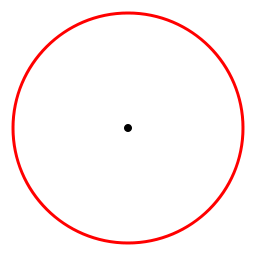Instruction
1
Let L be the length of the circumference, π a constant, the value of which is constant (π=3.14). Then, to determine the radius given the circumference, you need to use the formula:
R = L/2π
Example: length of a circle is 20 cm. Then the radius of this circle R = 20/2*3.14 = 3.18 cm
R = L/2π
Example: length of a circle is 20 cm. Then the radius of this circle R = 20/2*3.14 = 3.18 cm
2
Let the famous S - area of a circle. Then, knowing the formula for finding the area of a circle (S = πR2), it's easy to withdraw and another to determine the radius of a circle:
R = √(S/π)
Example: area of a circle is 100 cm2, then its radius is R = √(100/3.14) = 5.64 cm
R = √(S/π)
Example: area of a circle is 100 cm2, then its radius is R = √(100/3.14) = 5.64 cm
3
If the circumference length of the diameter (a line segment which connects two opposite points of the circle, passing through its center), the task of finding the radius is to divide the length of the diameter of the circle by 2.
Note
Besides the fact that the circle has radius and diameter, it can be constructed chord, Central angle, and inscribed angle. A chord is a segment connecting the 2 points of the circle not passing through its center.
The Central angle is a angle whose apex coincides with the center of the circle. The same inscribed angle is an angle whose vertex lies on any point of the circle.
A circle can also be described around some geometric shapes, or inscribed in it. A circle can be described around an equilateral triangle, square or any other regular polygon. To inscribe a circle in any of these figures.
The Central angle is a angle whose apex coincides with the center of the circle. The same inscribed angle is an angle whose vertex lies on any point of the circle.
A circle can also be described around some geometric shapes, or inscribed in it. A circle can be described around an equilateral triangle, square or any other regular polygon. To inscribe a circle in any of these figures.
Useful advice
If circle is inscribed in an equilateral triangle, a square or another polygon, the radius of this circle equals the square of the polygon is half its perimeter:
R = S/p.
If a circle circumscribed around a triangle, then its radius is set according to the formulas:
R=(a*b*c)/(4*S), where a, b, c be the sidelengths of a triangle, S is the area of the triangle;
R = a/2*sinα, where α is the angle opposite side a.
R = S/p.
If a circle circumscribed around a triangle, then its radius is set according to the formulas:
R=(a*b*c)/(4*S), where a, b, c be the sidelengths of a triangle, S is the area of the triangle;
R = a/2*sinα, where α is the angle opposite side a.

